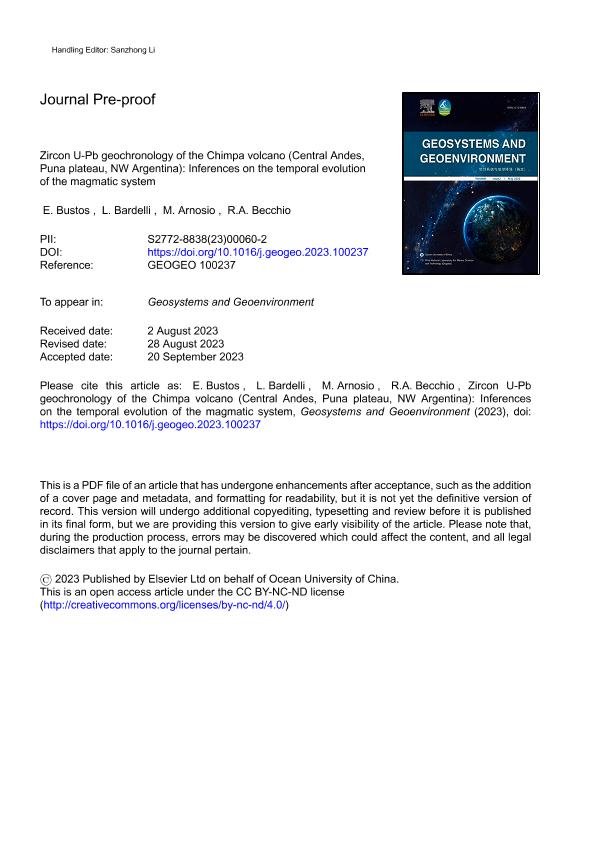Mostrar el registro sencillo del ítem
dc.contributor.author
Bustos, Emilce

dc.contributor.author
Bardelli, Lorenzo

dc.contributor.author
Arnosio, Marcelo
dc.contributor.author
Becchio, Raul Alberto

dc.date.available
2024-03-14T10:52:15Z
dc.date.issued
2023-10
dc.identifier.citation
Bustos, Emilce; Bardelli, Lorenzo; Arnosio, Marcelo; Becchio, Raul Alberto; Zircon U-Pb geochronology of the Chimpa volcano (Central Andes, Puna plateau, NW Argentina): Inferences on the temporal evolution of the magmatic system; Elsevier; Geosystems and Geoenvironment; 3; 1; 10-2023; 1-39
dc.identifier.issn
2772-8838
dc.identifier.uri
http://hdl.handle.net/11336/230442
dc.description.abstract
We investigated the temporal evolution of the andesitic Chimpa volcano of the northern Puna plateau, Central Andes, situated at the geological boundary between the plateau and the Eastern Cordillera domains. The volcanic activity consisted in three constructive volcanic cycles (Basal, Cajon, and Chimpa units) showing complex eruptive behaviors (ignimbrites, lava domes. block-and-ash flows, lava flows). We present new U-Pb analyses conducted on the zircon crystals from the Chimpa volcanic rocks. These analyses provide constraints on the magmatic/volcanic tempos and offer insights into the Th and U (and Th/U ratios) systematics of the analyzed zircon crystals. The results suggest a lifespan for volcanism ranging 7.5 to <7.0 Ma, in concomitance with the regional steady-state magmatic phase separating the first two pulses of ignimbritic flare-up in the Altiplano-Puna Volcanic Complex. Moreover, the analyzed zircon crystals exhibit Th/U ratios (0.11-0.34) and Th (33-8860 ppm) and U (52-4258 ppm) that indicate magmatic crystallization from poorly evolved melts at high temperatures. Some discrepancies exist between the calculated zircon concordia age for the third volcanic phase (Chimpa Unit, ca. 7.35 ± 0.071 Ma) and that of the second cycle (Cajon Unit, 6.98 ± 0.057 Ma). We interpret these differences as stemming from the presence of zircon antecrysts in the final eruptive melts. Indeed, a true pre-eruptive event of zircon crystallization (i.e., formation of autocrysts) could not be proven by the existing dataset.There is a geochronological affinity with some nearby volcanic rocks from the Puna plateau and the Eastern Cordillera domains, particularly considering the rhyolitic products of the Ramadas Volcanic Center and the andesitic to dacitic Almagro volcanic rocks. This highlights the complex behavior of the local magma plumbing system beneath this particular area, resulting in the emission of geochemically variegate volcanic rocks at similar times. This scenario suggests that the composition of the erupting melts are affected by the rheological behavior of the mid-upper-crustal MASH reservoir (the Altiplano-Puna Magmatic Body), which may either facilitate or impede the ascent of poorly evolved magmas derived from the deep crust towards the surface. From this point of view, the relative location of the volcanic centers relatively to the position of the geophysical anomaly may exert an important influence on the petrogenetic paths of magmas.
dc.format
application/pdf
dc.language.iso
eng
dc.publisher
Elsevier

dc.rights
info:eu-repo/semantics/openAccess
dc.rights.uri
https://creativecommons.org/licenses/by-nc-nd/2.5/ar/
dc.subject
PUNA PLATEAU
dc.subject
STEADY-STATE MAGMATISM
dc.subject
ZIRCON TH/U
dc.subject
ZIRCON U-PB AGES
dc.subject.classification
Vulcanología

dc.subject.classification
Ciencias de la Tierra y relacionadas con el Medio Ambiente

dc.subject.classification
CIENCIAS NATURALES Y EXACTAS

dc.title
Zircon U-Pb geochronology of the Chimpa volcano (Central Andes, Puna plateau, NW Argentina): Inferences on the temporal evolution of the magmatic system
dc.type
info:eu-repo/semantics/article
dc.type
info:ar-repo/semantics/artículo
dc.type
info:eu-repo/semantics/publishedVersion
dc.date.updated
2024-03-12T10:56:46Z
dc.journal.volume
3
dc.journal.number
1
dc.journal.pagination
1-39
dc.journal.pais
China

dc.description.fil
Fil: Bustos, Emilce. Consejo Nacional de Investigaciones Científicas y Técnicas. Centro Científico Tecnológico Conicet - Salta. Instituto de Bio y Geociencias del NOA. Universidad Nacional de Salta. Facultad de Ciencias Naturales. Museo de Ciencias Naturales. Instituto de Bio y Geociencias del NOA; Argentina
dc.description.fil
Fil: Bardelli, Lorenzo. Consejo Nacional de Investigaciones Científicas y Técnicas. Centro Científico Tecnológico Conicet - Salta. Instituto de Bio y Geociencias del NOA. Universidad Nacional de Salta. Facultad de Ciencias Naturales. Museo de Ciencias Naturales. Instituto de Bio y Geociencias del NOA; Argentina
dc.description.fil
Fil: Arnosio, Marcelo. Consejo Nacional de Investigaciones Científicas y Técnicas. Centro Científico Tecnológico Conicet - Salta. Instituto de Bio y Geociencias del NOA. Universidad Nacional de Salta. Facultad de Ciencias Naturales. Museo de Ciencias Naturales. Instituto de Bio y Geociencias del NOA; Argentina
dc.description.fil
Fil: Becchio, Raul Alberto. Consejo Nacional de Investigaciones Científicas y Técnicas. Centro Científico Tecnológico Conicet - Salta. Instituto de Bio y Geociencias del NOA. Universidad Nacional de Salta. Facultad de Ciencias Naturales. Museo de Ciencias Naturales. Instituto de Bio y Geociencias del NOA; Argentina
dc.journal.title
Geosystems and Geoenvironment
dc.relation.alternativeid
info:eu-repo/semantics/altIdentifier/url/https://linkinghub.elsevier.com/retrieve/pii/S2772883823000602
dc.relation.alternativeid
info:eu-repo/semantics/altIdentifier/doi/http://dx.doi.org/10.1016/j.geogeo.2023.100237
Archivos asociados
